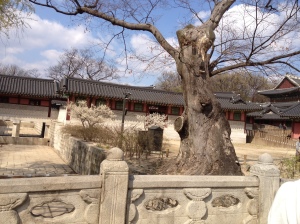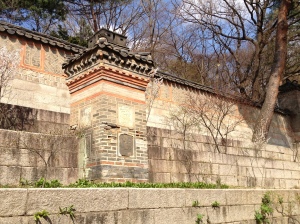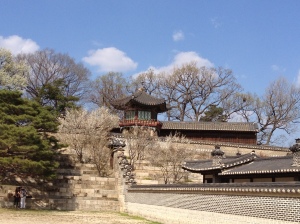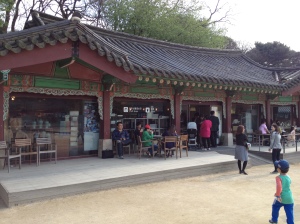One of the most historically significant sites in Seoul is Changdeokgung, or Cheongdeok Palace. It was the favorite palace of the rulers of Korea back when Korea was ruled by an emperor. Unlike Japan, which has a figurehead Emperor with a role similar to the Queen of England, Korea’s emperor system was abolished during the Japanese occupation. If you take the English tour of the palace your guide will tell you several stories about emperors and empresses who lived in the Imperial Palace, most of which are quite sad.
In any case, the palace is stunning visually and architecturally, as one would expect. Much like the Bulguk-sa, the architecture of the palace is characterized by bright colors, the most predominant of which are green, yellow, and brown. What struck me about the coloring of the palace was that it was very well balanced and no one color really stood out. The colors all seemed to blend and harmonize well.
Unlike Western-style palaces which tend to be one large, self-contained building, the Cheongdeok Palace is spread out over a large area and is comprised of a number of smaller yet no less impressive structures.
One of the largest—if not the largest—buildings housed the Emperor’s throne room. I don’t know if the throne inside is the original one the emperors used to use, but you can get pretty close to take pictures:
One thing that was pretty interesting about the layout of the palace was the way the paths were constructed. The paths leading from building to building and gate to gate are comprised of two layers of elevated stone. The top layer is narrower and elevated just a little above the one under it. Apparently the top path was for the emperor, and his entourage walked on either side of him, on the lower path, so that the emperor was always elevated above those around him.
Another building of note on the palace grounds was the emperor’s study, which is more or less exactly what you’d expect it to be. Apparently it wasn’t actually used very much, though, because it was kind of small and didn’t have any kind of heating system. Hmm, for some reason I feel like I can relate…
It’s kind of a shame that the study wasn’t often put to use, though, because it seems that it was a pretty expensive building to construct. The roof of the study is a beautiful, vibrant greenish-blue, and it’s the only building in the complex to have this kind of coloring. That’s because the coloring on the roof tiles came from Arabia and it was far too expensive to use on the roofs of the other buildings.
Instead of using his study, the emperor would usually do his administration work from the comfort of his personal quarters, at least until the Japanese occupation. When Japan occupied Korea the emperor was stripped of all his power and his siblings were taken to Tokyo to be educated. It’s a pretty sad story. During the time of the occupation a fire broke out in the emperor’s quarters, the cause of which is still unknown, and Japan rebuilt the damaged property, so that area of the palace is a reconstruction. Interestingly, the entrance to the building was once rather large and grand, but the Japanese rulers in the area decided that the emperor didn’t need such a large entrance since people no longer used horses and carriages. So, instead, they built him a driveway so that he could pull up to the entrance in his car.
Standing directly behind the emperor’s quarters are the empress’s quarters. According to our guide, after the Japanese occupation the emperor decided to live there with his wife since he felt that his country had been taken from him and he was no longer truly an emperor.
The empress’s quarters are quite beautiful, and inside there’s a huge desk covered with Korean lacquer and mother-of-pearl, a kind of craftsmanship that Korea is famous for.
Behind the empress’s quarters there’s a garden full of trees and flowers. There was a rule in the palace that no one was allowed to plant gardens because the emperor and his ministers seemed to think that gardens would be too distracting for the imperial workers. I guess before TV people were distracted a little more easily by plant life. Anyway, the only person in the palace grounds who was allowed to grow a garden was the empress.
There actually is an area called the “Secret Garden” where there are plenty of trees and flowers, and it’s situated right beside the palace, lest you think the emperors were complete sticklers.
In Korea, like many nations, the emperors sometimes also had concubines. There’s actually an entire cluster of buildings that (if memory serves) were built as a residence for a certain emperor’s concubine. When he was crowned emperor he needed to find a bride, so he, his mother, and his grandmother conducted a large-scale search for eligible women. The candidates were brought to the palace and the emperor fell in love with one of them, but his mother and his grandmother didn’t approve of his choice. Even though he was an emperor it seems he didn’t have the power to overrule his mother and his grandmother, so he married his second choice instead of the woman he loved. And because the woman he loved had been a candidate to marry the emperor, no other man in Korea dared to court her. She had no choice but to leave the palace and live alone.
However, there was a loophole in the imperial rules of marriage: if the empress couldn’t conceive a child within three years, the emperor was legally allowed to take a second wife. As it turns out his first wife wasn’t able to conceive, so he was finally able to marry the woman he loved, and she became his concubine. He had this complex, called Nakseonjae, built for her.
The story has kind of a sad ending, though. After about a year of happy marriage the emperor died and the concubine he loved once again lived alone, this time in Nakseonjae.
I was actually pretty lucky to see this complex at all, because it only became available for tourists to visit in 2006. Up until the late eighties it was still inhabited by the last Korean princess.
The last building of note in the Imperial Palace grounds is the old waiting room. It was built as a place for guests to wait before being received by the emperor. After the Japanese occupation the emperor didn’t have many visitors, so the Japanese rulers turned it into a royal garage for his car. And now it’s a gift shop! This building has undergone a lot of changes in the past hundred and fifty years.
Before I visited Korea my friend—who had been there before—told me that if I saw only one palace during our visit it should definitely be the Cheongdeok Palace. Having seen a couple, I certainly agree; it’s a beautiful place with a fascination and tragic history. Hearing the stories of the Korean Emperors made me really curious to learn more about the history of the nation before the Korean War.
I can’t help but think that being royalty in this day in age is a huge pain. I mean, the Nakseonjae was closed to visitors until recently, but the rest of the palace grounds were open, meaning that the last Korean princess had to deal with tourists constantly crawling around near her home. I’ve also heard that the Imperial Palace grounds in Tokyo are open to visitors all year ‘round and that on the emperor’s birthday tourists can even go inside the palace to take a look. Can you imagine having to deal with that on your birthday? I think I’d skip town and party in Jamaica or something.





















